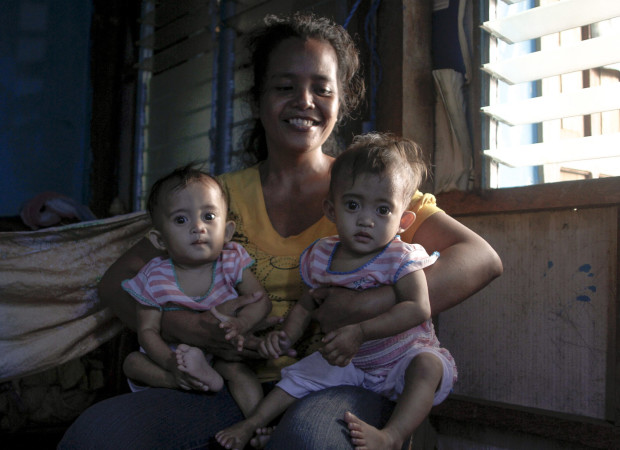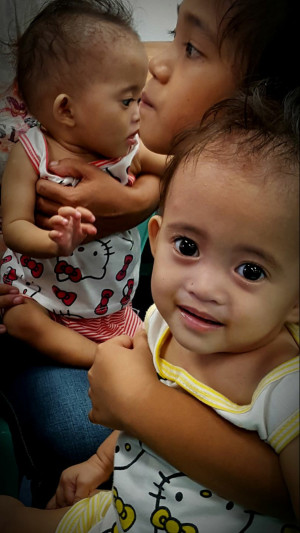DOH, Unicef band together to care for severely malnourished kids

Rose Anne Cordero’s twins Angel and Lourdes are on their way to recovery after receiving antibiotics and ready-to-use therapeutic food from the Department of Health’s Severe Acute Malnutrition Program. ©UNICEF Philippines/2017/Torralba
A child’s first birthday is a great milestone for every mother. But for Rose Anne Cordero of Tacloban City, seeing her twins Angel and Lourdes sickly and unable to walk as they turned a year old became a cause for worry.
The concerned mother turned to Barangay Health Worker Rosario Fuerte for help. Upon referral to the Eastern Visayas Regional Medical Center (EVRMC), the twins were found to be severely malnourished. Although Rose Anne continues to breastfeed her twins, she is only able to add rice and a few pieces of vegetables to complement their diet because of their limited income. Not having the means for the children’s treatment, she decided to take the twins home.
“I did not have enough money to buy their medications so I decided to leave the hospital with my twins after they were seen by the doctor. I took the prescription with me hoping that I would have money to spare to buy the medicines,” she said.
Lives cut too short
Angel and Lourdes are only two of the estimated 300,000 children in the Philippines who are severely malnourished. Acute malnutrition or wasting is a life-threatening form of malnutrition. Children with severe wasting, called severe acute malnutrition (SAM), are nine to 12 times more likely to die compared to other children.
“In the Unicef Global Nutrition Database, the Philippines ranks tenth in the world with the highest number of children under five years old who are moderately or severely wasted. SAM cases, although prevalent in all regions of the country, are usually found in the disadvantaged communities and get worse during times of emergencies,” Unicef Philippines Nutrition Policy Specialist Joris van Hees said.
Article continues after this advertisementThe 2015 National Nutrition Survey also showed that wasting prevalence in Region VIII, where Rose Anne and her family resides, is 6.8 per cent which is slightly lower as compared to the national average.
Article continues after this advertisementA new beginning
Through the partnership of the Department of Health and Unicef, hope came to Angel and Lourdes. The twins were among the first children with severe acute malnutrition to receive the Ready-to-Use Therapeutic Food (RUTF) that DOH procured through Unicef. RUTF is a specialized paste specifically designed to give SAM children all the nutrients they need to recover. Nutrition supplies such as ready-to-use therapeutic food (RUTF) were delivered to priority provinces last March to treat up to 50,000 children who are severely malnourished.

The Department of Health and UNICEF are working together to end child malnutrition in the Philippines. ©UNICEF Philippines/2017/Torralba
The SAM Management Trainings being conducted by DOH and Unicef enables health workers to diagnose more and more children like Angel and Lourdes with severe acute malnutrition. For children to start their journey to receive proper nutrition, their mid-upper arm circumference (MUAC) should be measured while also assessed for any medical complications and ensured that they have good appetite.
With technical support from Unicef, DOH began scaling up SAM management services in 17 initial provinces in 2016. This includes the development of standard training modules on the management of Severe Acute Malnutrition and a series of capacity building sessions for early detection.
“I am really happy that Lourdes and Angel are being treated. I noticed that my twins are getting better and have become more physically active since they started taking the RUTF,” Rose Anne said.

A week after admission, Angel and Lourdes are now more active and have gained weight. ©Hermart Severino
Angel and Lourdes can now visit the nearest Barangay Health Station to receive routine antibiotics and daily rations of Ready-to-Use Therapeutic Food (RUTF) through the Out-patient Therapeutic Care (OTC) of the DOH. Rose Anne was also taught by the health workers to continue giving the medications and the RUTF to the children at home. She reports to the Health Station weekly so that the Barangay Health Workers can monitor the twins’ progress.
A boost for nutrition
Unicef’s engagement with the Philippine government for severe acute malnutrition began with the development and implementation of the “National Guidelines on the Management of Severe Acute Malnutrition for Children under Five Years” in 2015. As one of the first countries in the South East Asia and the Pacific Region to do this, the Philippine Government is highly committed to the integration of services for management of children with SAM into the routine health care system.
Through Unicef’s advocacy, the DOH invested more than Php150M (US$3.3M approximately) in 2016 to procure SAM supplies, such as RUTF and therapeutic milk. The supplies were procured through global supply and logistics network of Unicef, ensuring that the products are safe, of high quality and of good value investment.
A week after admission, Angel and Lourdes have gained weight and are now more active. Their MUAC measurements have increased to 12.3 cm and 12.2 cm, respectively, which are not far away from the standard measurement of 12.5 cm. With continued RUTF treatment, the girls are projected to attain normal nutritional status in a few more weeks. As part of the program, Rose Anne also receives focused counselling on breastfeeding, complementary feeding and good nutrition. — Alvin Manalansan, Alanah Torralba, and Rene Gerard Galera/rga
To help save children like Angel and Lourdes from malnutrition, donate now at https://www.donate.unicef.ph/c